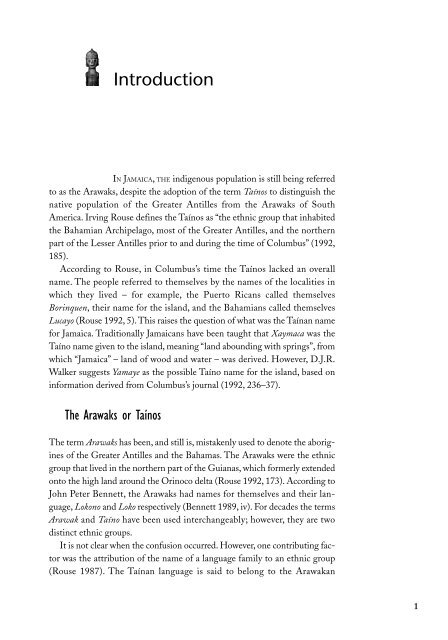The Earliest Inhabitants: The Dynamics of the Jamaican Taino
by Lesley-Gail Atkinson
by Lesley-Gail Atkinson
You also want an ePaper? Increase the reach of your titles
YUMPU automatically turns print PDFs into web optimized ePapers that Google loves.
Introduction<br />
IN JAMAICA, THE indigenous population is still being referred<br />
to as <strong>the</strong> Arawaks, despite <strong>the</strong> adoption <strong>of</strong> <strong>the</strong> term Taínos to distinguish <strong>the</strong><br />
native population <strong>of</strong> <strong>the</strong> Greater Antilles from <strong>the</strong> Arawaks <strong>of</strong> South<br />
America. Irving Rouse defines <strong>the</strong> Taínos as “<strong>the</strong> ethnic group that inhabited<br />
<strong>the</strong> Bahamian Archipelago, most <strong>of</strong> <strong>the</strong> Greater Antilles, and <strong>the</strong> nor<strong>the</strong>rn<br />
part <strong>of</strong> <strong>the</strong> Lesser Antilles prior to and during <strong>the</strong> time <strong>of</strong> Columbus” (1992,<br />
185).<br />
According to Rouse, in Columbus’s time <strong>the</strong> Taínos lacked an overall<br />
name. <strong>The</strong> people referred to <strong>the</strong>mselves by <strong>the</strong> names <strong>of</strong> <strong>the</strong> localities in<br />
which <strong>the</strong>y lived – for example, <strong>the</strong> Puerto Ricans called <strong>the</strong>mselves<br />
Borinquen, <strong>the</strong>ir name for <strong>the</strong> island, and <strong>the</strong> Bahamians called <strong>the</strong>mselves<br />
Lucayo (Rouse 1992, 5). This raises <strong>the</strong> question <strong>of</strong> what was <strong>the</strong> Taínan name<br />
for Jamaica. Traditionally <strong>Jamaican</strong>s have been taught that Xaymaca was <strong>the</strong><br />
Taíno name given to <strong>the</strong> island, meaning “land abounding with springs”, from<br />
which “Jamaica” – land <strong>of</strong> wood and water – was derived. However, D.J.R.<br />
Walker suggests Yamaye as <strong>the</strong> possible Taíno name for <strong>the</strong> island, based on<br />
information derived from Columbus’s journal (1992, 236–37).<br />
<strong>The</strong> Arawaks or Taínos<br />
<strong>The</strong> term Arawaks has been, and still is, mistakenly used to denote <strong>the</strong> aborigines<br />
<strong>of</strong> <strong>the</strong> Greater Antilles and <strong>the</strong> Bahamas. <strong>The</strong> Arawaks were <strong>the</strong> ethnic<br />
group that lived in <strong>the</strong> nor<strong>the</strong>rn part <strong>of</strong> <strong>the</strong> Guianas, which formerly extended<br />
onto <strong>the</strong> high land around <strong>the</strong> Orinoco delta (Rouse 1992, 173). According to<br />
John Peter Bennett, <strong>the</strong> Arawaks had names for <strong>the</strong>mselves and <strong>the</strong>ir language,<br />
Lokono and Loko respectively (Bennett 1989, iv). For decades <strong>the</strong> terms<br />
Arawak and Taíno have been used interchangeably; however, <strong>the</strong>y are two<br />
distinct ethnic groups.<br />
It is not clear when <strong>the</strong> confusion occurred. However, one contributing factor<br />
was <strong>the</strong> attribution <strong>of</strong> <strong>the</strong> name <strong>of</strong> a language family to an ethnic group<br />
(Rouse 1987). <strong>The</strong> Taínan language is said to belong to <strong>the</strong> Arawakan<br />
1


















